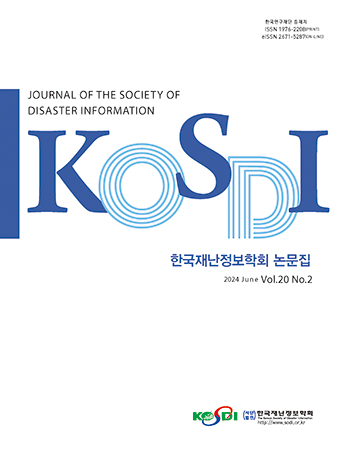Original Article
Abstract
References
Information
Purpose: In order to conduct a spontaneous ignition test in which a fire occurs in the absence of an ignition source due to the oil adsorbed on the towel. A phenomenon in which spontaneous ignition occurs when adsorbed to fibers using flaxseed oil, which is drying oil and olive oil, which is non-drying oil, is tested through an experiment. Method: After placing the sample container in the experimental device, observe the change in the central temperature of the sample, and when the central temperature rises above the set temperature and a fire occurs, it is judged as “ignition”, and the experiment is stopped after checking the maximum value of the central temperature of the sample,When the central temperature of the sample was maintained similar to the set temperature, it was judged as “non-ignition” and the experiment was stopped. Result: In the towels with adsorbed flaxseed oil, the temperature in the sample container increased rapidly and combustion occurred in sheets 5, 10, and 15. Olive oil is a non-drying oil, does not ignite because it is difficult to dry because carbon is a single bond and it is difficult to bond with oxygen. Conclusion: It was confirmed that the more the amount of towel adsorbed to the drying oil, flaxseed oil, the longer the time to reach the set temperature and the occurrence of ignition.
연구목적: 타올에 흡착된 기름에 의하여 점화원이 없는 상태에서 화재가 발생되는 자연발화 실험을 하기 위하여 건성유인 아마인유와 불건성유인 올리브유를 사용하여 섬유에 흡착되었을 때 자연발화가 발생되는 현상을 실험을 통하여 화재가 발생되는 현상을 확인하였다. 연구방법: 시료용기를 실험장치에 넣은 후 시료의 중심온도 변화를 관찰하여 중심온도가 설정온도 보다 상승하고 화재가 발생하였을 때를 「발화」로 판정하여, 시료의 중심온도 최대치를 확인한 후 실험을 중지하였으며, 시료의 중심온도가 설정온도와 유사하게 유지되었을 경우 「비발화」로 판정하고 실험을 중지하였다. 연구결과: 아마인유가 흡착된 타올은 5장, 10장, 15장에서 모두 시료용기 내의 온도가 급상승되고 연소가 발생되었으나, 불건성유인 올리브유는 탄소가 단일결합으로 되어 있어 건조가 어렵고 산소와의 결합이 어렵기 때문에 발화가 되지 않았다. 결론: 건성유인 아마인유가 흡착된 타올의 량이 많을수록 설정온도에 도달되는 시간이 길어지는 현상으로 발화가 발생되는 것을 확인하였다.
- ASTM E0659-15 (2016). American Society for Testing and Materials. Standard Test Method for Autoignition Temperature of Chemical.
- Bowes, P.C., Thomas, P.H. (1966). "Ignition and extinction phenomena accompanying oxygen dependent self-heating of porous bodies." Combustion and Flame, Vol. 10, No. 3, pp. 221-230. 10.1016/0010-2180(66)90078-2
- Cameron, A., MacDowall, D. (1972). "The self heating of commerical powdered activated carbons." Journal of Applied Chemistry and Biotechnology Banner, Vol. 22, No. 9, pp. 1007-1018. 10.1002/jctb.5020220908
- Choi, J.W., Mok, Y.S., Ha, D.M. (2001). "A study on spontaneous ignition of hydroxy propyl methyl cellulose." Journal of Korean Institute of Fire Science and Engineering, Vol. 15, No. 4, pp. 34-40.
- Choi, J.W., Jun, S.G. (2018). Fire Safety Engineering. Hwa Su Mog, pp. 92-93.
- Choi, J.W., Kim, S.Y., Lee S.R., Choi, K.J. (1993). "A study on the ignition induction time and temperature distribution at spontaneous ignition of activated carbon." Journal of the Korean Society of Safety, Vol. 8, No. 3, pp. 44-49.
- Choi, J.W., Mok, Y.S., Ha, D.M. (2001). "A study on spontaneous ignition of hydroxy propyl methyl cellulose." Journal of Korean Institute of Fire Science and Engineering, Vol. 15, No. 4, pp. 34-40.
- Choi, Y.J. (2017). A Study on the Spontaneous Ignition Charactistics of Wood Pellets and Powders Used as Mixtures in Themal Power Plants, Ph.D. Dissertation, Pukyong National University Graduate School, pp. 1-3.
- Fire Department (2011~2017). Fire Status Statistics. National Fire Information System. (NFDS; National Fire Data System), https://www.nfds.go.kr/fr_scls_0201.jsf.
- Kim, C.J., Park I.S., Sohn, C.H. (2010). "Numerical study on the phenomenon of spontaneous ignition of coal stockpile." The Korean Society of Mechanical Engineers, Vol. 34, No. 7, pp. 721-727. 10.3795/KSME-B.2010.34.7.721
- Lim, W.S., Choi, J.W. (2008). "Thermal stability and critical ignition temperature of RPF." Journal of Korean Institute of Fire Science and Engineering, Vol. 22, No. 1, pp. 99-104.
- Ministry of Food and Drug Safety (2022). Standards and Specifications by Food, Food and Food Additives Code. https://www.foodsafetykorea.go.kr/foodcode/03_02.jsp?idx=28.
- Mok, Y.S., Choi, J.W. (2001). "A study on autoignition characteristics of methylmethacrylate-butadiene-styrene copolymer." Journal of the Korean Society of Safety, Vol. 16, No. 3, pp. 83-88.
- Ryu, J.W., Choi, J.W. (2013). New Hazardous Materials Theory, Vision Communication, pp. 249-374.
- Safety Engineering Association (1983). Fire. Haemundang, Japan, pp. 23-26.
- Publisher :The Korean Society of Disaster Information
- Publisher(Ko) :한국재난정보학회
- Journal Title :Journal of the Society of Disaster Information
- Journal Title(Ko) :한국재난정보학회논문집
- Volume : 18
- No :2
- Pages :324-332
- DOI :https://doi.org/10.15683/kosdi.2022.6.30.324




 Journal of the Society of Disaster Information
Journal of the Society of Disaster Information







